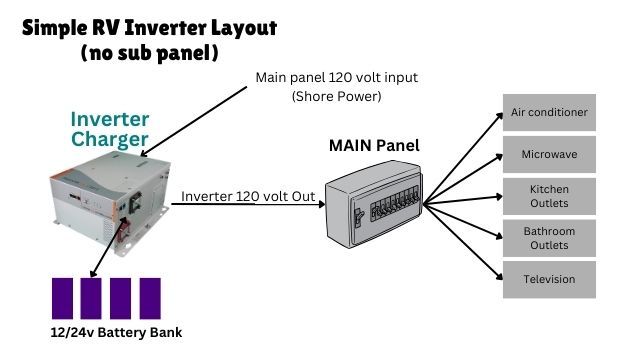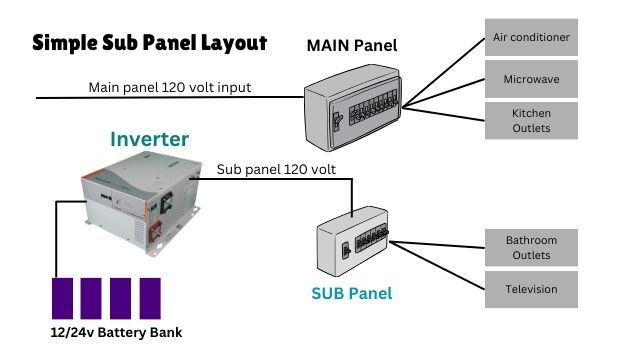How to Wire Inverter to RV Breaker Box
When upgrading the electrical system in your RV, eventually you’re going to have to learn how to wire inverter to RV breaker box.
First you will need to make a few decisions on what you want your RV inverter to run. That will be determined by two things. The size of your RV battery bank and the amount of appliances you want to run off your system.
What is an Inverter?
According to Energy.gov, an RV inverter is “just one example of a class of devices called power electronics that regulate the flow of electrical power.”
Let me see if I can put that in plain English.
An RV inverter takes the stored DC power from your battery bank. Then “inverts” or changes it from 12 or 24 volts to 110 volt AC power, to be used for your appliances.
An inverter is a very important part of an off-grid or RVs electrical system. Especially if you are using solar power for either.
How to Wire Inverter to RV Breaker Box: Step by Step (Simplified)
(NOTE: Before doing any electrical work on your RV. Seek the help of a professional electrician to avoid the risk of shock)
- Find an area close to your battery bank with plenty of space to allow heat to escape from your inverter.
- Secure the inverter
- Decide whether your install will require the use of a sub panel to only run specific appliances
- If you use a sub panel. Run wires from the 120 volt output from the RV inverter to the input of the sub panel.
- Connect the appliances you want to run to the breakers on the sub panel.
- If you are not using a sub panel. Your main 120 volt wires connect directly to the input of your inverter.
- Run wires from your 120 volt AC output on the inverter to the input of the transfer switch (if available).
- Run wires from your battery bank into the 12 volt input of your inverter.
- You should have breakers or fuses and cut off switches installed in the appropriate places.
To Use a Sub Panel, Or To Not Use a Sub Panel?
Ah yes, the age old question of whether or not you should use a sub panel for your inverter install. Again, this is a question of what you need your inverter to do.
Whether you are installing an inverter in an RV or an off-grid cabin, you have an important decision to make. You’ll need to determine how many appliances or devices you plan to run off your solar system.
In our install on our RV, we made the decision to run the entire 120 volt system off the inverter. The only thing we have to be careful with is turning on our air conditioning with other things running.

We have a 30 amp system in our RV. It has special air conditioners that perform a “shedding” process allowing them to run, even on a 30 amp circuit. Our RV inverter is 3,000 watts, so it will also allow the air conditioners to run off of it.
The biggest problem we run into is not having the RV solar panel and battery capacity to keep them running for long periods of time. Even during a sunny day.
As long as we don’t run our air conditioners we almost have unlimited AC power available to us. We can be conservative with the rest of our appliances and run off of our battery and solar pretty easily.
With a separate sub panel, we could have eliminated the worry of our air conditioners draining our solar system power to zero and not having enough to make it through the night.
If you want to run ALL of your appliances you may need more than one inverter if you have an inverter without enough reserve power.
The alternative is to only run some of your appliances off the inverter by separating out some of your appliances from your main electrical panel using a “sub panel.”

Both graphics above are very simplistic layouts of a main panel and sub panel wiring diagram.
The wiring above may not be exactly how you would wire your system with a sub panel, but this should get your creative electrical juices flowing.
Some RV electrical systems will have an automatic transfer switch that allows the electrical system to automatically switch between shore power and generator power so you will need to take this into account.
In our installation the Xantrex SW3012 has a pass-through feature that allowed us to go from shore power into our inverter and then directly into the transfer switch where the original shore power would have gone.
This made the 120 volt system very easy to wire.
You will have to check your inverter for these features and figure out how it would work best.
Final Thoughts on How to Wire Inverter to RV Breaker Box
Wiring your RV inverter to your RV breaker box is not an extremely difficult DIY project. It will take some time and some planning, but you really can do it with basic tools and a little precaution.
Again, we recommend using an electrical professional if you are uncomfortable at all because 120 volt electrical can be dangerous.
The hardest part of our RV inverter install was getting the wires from the RV inverter, which was close to the stairs, back to the main electrical panel in the back bedroom. Yours may be easier if your main panel is closer to that area.
Upgrading your RV electrical system can be very rewarding. Have fun!
